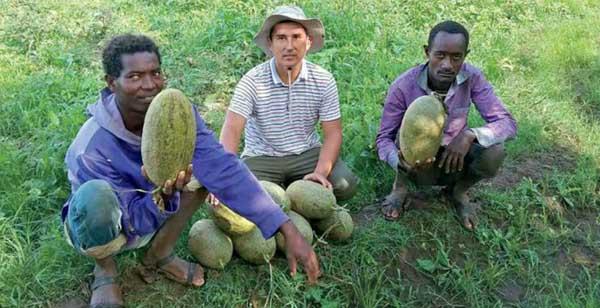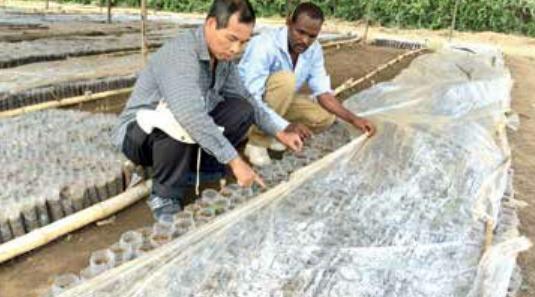Lessons in the Field
By Liu Jian


Also called snow melon, the cantaloupe-like fruit thats white, green or yellow outside and crispy and sweet inside, is most popularly known as Hami melon in China. The name comes from Hami, a city in the Xinjiang Uygur Autonomous Region in northwest China where it grows plentifully.
Yushanjiang Maimaiti, who comes from Xinjiang himself, cant help but beam in pride at the sight of clusters of Hami melons growing lusciously in the little plot he has cultivated for five months. The twist in the tale: the plot of land is not in Xinjiang but in Alage, south of Ethiopias capital city Addis Ababa. Theres a bit of history involved in this too as this is the first time the Hami melon is being grown on Ethiopian soil.
When 36-year-old Maimaiti, a Chinese agricultural expert from the Xinjiang Academy of Agricultural Sciences, came to teach at the Alage Agricultural Technical Vocational Education and Training (ATVET) College in Ethiopia last November as part of a China-Ethiopia cooperation in ATVET, he found the climate similar to that of his hometown in Xinjiang - with plenty of sunshine but a shortage of water.
Maimaiti thought it was perfect for growing the Hami melon, which would increase Ethiopian farmers profits.“We harvest the melon once a year in my hometown. But as there is plenty of strong sunshine here, it can be harvested several times a year,” he told ChinAfrica. “If Ethiopian farmers learn the technology and solve the water shortage problem, there is the potential to export the Hami melon and watermelon to countries like Saudi Arabia.”
Introducing new technologies
After arriving in Alage, Maimaiti realized one of the challenges to growing crops was the scarce rainfall. In Ethiopia, it rains on average once every 15 days between June and October, but in the dry season, the Alage area can go without seeing a drop for months.
To address this problem, he introduced the technique of drip irrigation, which delivers water directly to individual plants through a network of pipes and emitters. To make the drip irrigation system more efficient, he also used plastic mulching. In this way, he succeeded in growing Hami melons, watermelons, tomato and pepper.
There were some problems. When he tried to introduce drip irrigation at the plant demonstration center in the college, he found it difficult to buy the pipe connec- tors. However, he was persistent and after searching for two weeks, bought them from a local flower shop.
This April, Maimaiti trained over 40 agricultural technicians from the northwestern Ethiopian state of Benishangul-Gumuz to use drip irrigation and plastic mulch to grow the Hami melon and pepper.
Temertu Sahlu, Vice Chancellor of the Alage ATVET College, said drip irrigation has great potential for Ethiopia, especially in the dry season. “We will start building ponds for water conservation soon. After that, we would install the drip irrigation system,” he said.
The college plans to use drip irrigation to grow the Hami melon, watermelon and pepper in a field with an area of 3 to 4 hectares and then extend it. “We need technical and material support from Chinese experts like Maimaiti,” Sahlu said.
Building capacity
Life isnt easy for the visiting Chinese experts. They have to cope with Ethiopias dry climate, poor Internet connection, power cuts and inadequate water supply. Yet the harsh living conditions as well as the lack of materials and limited funding cant deflect them from introducing new agricultural techniques and technologies in Ethiopia.
The Chinese experts visits started since the Chinese and Ethiopian governments agreed to cooperate on ATVET in 2001. In 16 years, over 400 Chinese experts from Chinas agricultural colleges, universities and research institutions have been working on the bilateral ATVET program. They have introduced more than 70 advanced agricultural techniques and technologies. Over the years, the Chinese experts have taught 56 courses in botany, zoology, natural resources and veterinary sciences, and trained around 2,100 local teachers, 1,300 agro-technicians and 39,000 students in 13 vocational colleges.
Duan Zhenhua, a vet from the Yulin Animal Disease Control and Prevention Center in south Chinas Guangxi Zhuang Autonomous Region, came back to Ethiopia in 2015 after spending two years there earlier on a ChinaEthiopia South-South Cooperation agricultural project.
In February, Duan volunteered to train 45 Ethiopian vets for two weeks, demonstrating how to neuter rams and give them injections.
“The students here are good at theory but lack prac- tical skills,” Chen Xiongzhen, a sericulture expert, said. “I hope I can teach them more practical techniques.”
Su Xuejun, an expert on soil and fertilizers from the Nanning Soil and Fertilizer Station in Guangxi, made 2-meter-high nets to provide shade for seedlings from the scorching sun. “Thanks to the new shading nets, the quality of seedlings has been much improved,” Su said.“I have taught Ethiopian teachers how to use the nets to protect seedlings and manage them.”
Altogether 70,000 seedlings in seven varieties have been planted so far. Nearly 700 students have done their internship and over 100 local agricultural technicians have been trained.
After assessing the local climate and soil, Su has also introduced the balanced cropping system, which integrates the technologies of soil conservation, rainwater collection and crop residues cycling. “The new system has stably and sustainably increased crop yield,” he said.
In addition to raising the practical skills of both Ethiopian students and teachers, Chinese teachers have also worked with their Ethiopian peers to build fishponds, advanced chicken coops, a silkworm farm, greenhouses and model agricultural plots to demonstrate practical technologies and introduce new varieties of crops.
“The demonstration centers set up by the Chinese experts are very useful for the practical training of students and the transfer of technologies to the neighboring communities and local farmers,” Sahlu said.

